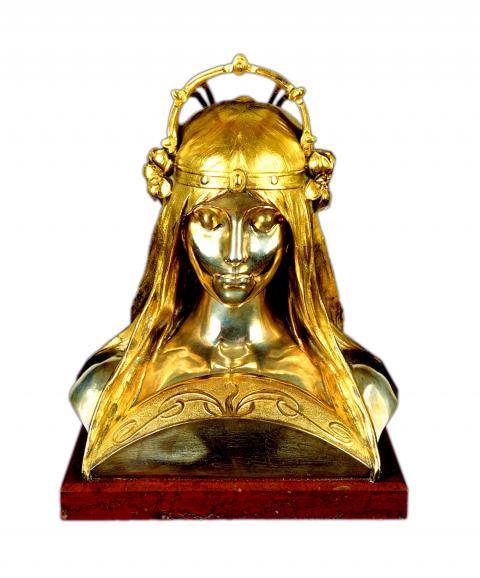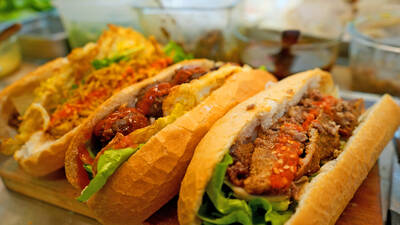When Czech artist Alphonse Mucha died on the eve of World War II, he was a disillusioned man. Ridiculed by the public for his Slav nationalist sentiments and persecuted by the Nazis for his art and Freemason activities, Mucha spent much of his career trying to detach himself from the Art Nouveau label that had stuck to him since he gained overnight fame in 1895.
Alphonse Mucha: Art Nouveau and Utopia, currently on view at the National Palace Museum’s Library Building, proves the thesis that he is more than the sum of the 10 years he spent in Paris at the end of the 19th century. Roughly 200 objects (paintings, posters, jewelry, newspapers and sculpture) from the Mucha Museum focus more on the “utopia” of the title than the Art Nouveau (“new art”) movement that many consider him the greatest exponent of.
“We want to dynamite — and I deliberately use the word dynamite — the concept that Alphonse was just an Art Nouveau artist,” John Mucha, the artist’s grandson and president of the Prague-based Mucha Museum, told the Taipei Times at the opening of the exhibit.

Photos courtesy of NPM and Mucha Foundation
It’s a sentiment echoed by Tomoko Sato, the exhibit’s curator.
“He didn’t call himself an Art Nouveau artist,” Sato said. “He was fully aware of the movement but he didn’t want to be represented as part of it. He was too much an individualist.”
Sato said the roots of Alphonse Mucha’s art can be found in the bucolic rural imagery and folk culture of Moravia (part of today’s Czech Republic) where he was born in 1860, pagan symbols and the religious archetypes, architecture and iconography of the Eastern Orthodox Church. Sato called these “secular icons” — religious iconography employed in a secular context.

Photos courtesy of NPM and Mucha Foundatio
Still, as John Mucha admits, if it wasn’t for the decade spent in Paris and the art movement many associate
him with, Alphonse Mucha would probably only be a minor footnote to Europe’s fin de siecle art, an illustrator of eye-catching posters rather than an artist of international significance.
“In terms of relative importance — Cubism say — [Alphonse] Mucha is the Picasso of Art Nouveau. He was that fundamental,” John Mucha said.
Paris in the final decade of the 19th century was the artistic center of Europe, a city of experiment and extravagance. Artists depicted its streets, rivers and cafes where writers got drunk and wrote essays, poetry and plays denouncing the degeneracy of the recent past, while anticipating an age of renewal they thought the 20th century would usher in. Art, they felt, would play a vital role in bringing about a spiritual emancipation from the strictures of the past. It was in this belle epoque atmosphere of febrile ideas that Alphonse Mucha promoted reform in the teaching of art and developed a style that abolished the division between high and low art.
Though there were minor successes, he was generally regarded as a commercial artist, producing magazine drawings and designing costumes for operas. This all changed when his commissioned poster for Gismonda, a play starring the famous actress Sarah Bernhardt, appeared on the streets of Paris in 1895.
It caused a sensation and brought Alphonse Mucha fame in Europe and the US. The New York Daily News declared him “the greatest decorative artist in the world,” a stylist who became synonymous with internationalism and cosmopolitanism.
Gismonda hangs at the front of the National Palace Museum show and serves as an introduction to Alphonse Mucha’s (and to a lesser extent the Art Nouveau) early style: ornamental flourishes with elements of Japonism, or the woodblock prints from Japan that were all the rage in Paris at the time. It depicts Bernhardt dressed in a sumptuous gown emblazoned with floral motifs. The craftsmanship is simple yet elegant, the muted pink flowers, green foliage and blue outlines serving as a nice counterpoint to the decorative touches of silver and gold.
It is difficult in today’s media-saturated and commercialized world to appreciate the novelty the poster exerted on the public at the time. “In Paris, [it] looked very exotic,” Sato said.
Surprisingly, it still does today.
But there is more going on here. As with many of the roughly 20 posters on display from Alphonse Mucha’s Paris period, Gismonda illustrates how he blended art with advertising, pagan symbols with Eastern Orthodox iconography, Byzantine mosaics with church architecture.
In contrast to other artists who were perceived to be Art Nouveau, Alphonse Mucha was convinced that art should not just concern itself with the new, but should develop out of older traditions — which for him meant Slavic culture and identity.
Following a trip through the Balkans in preparation for the Bosnia-Herzegovina pavilion at the World Exhibition in Paris, Mucha came to the conclusion that he should turn his considerable talents to promoting a Czech state.
“He became a very keen nationalist who worked for the independence of his country,” Sato said.
Sketches from Alphonse Mucha’s Slav Epic, a monumental undertaking that took him 20 years to complete and includes 20 massive panels mythologizing Slavic civilization, illustrate his devotion to this cause, one that would later see him design, gratis, everything from the Czech currency to police uniforms.
Ironically, few in his homeland considered him the ideal candidate to express Slavic culture or Czech identity. Indeed, many considered Alphonse Mucha a Frenchman, and a commercial artist to boot — a slap in the face for someone increasingly obsessed with the epic depiction of his own cultural heritage.
“When he was alive, there was a significant element of Czech society that made damn sure that he got his teeth kicked in,” John Mucha said.
The unveiling of the Slav Epic, which Mucha donated to the newly formed Czech nation in 1928, attracted considerable derision from critics, who felt that its execution was dated and Slav nationalism an illusion.
“We know from the archives that his heart was
broken because something that he regarded as the most important part of his creative life was being dismissed,” John Mucha said.
Sato stressed that Mucha’s brand of nationalism was benign. “He wasn’t satisfied with pure Slavonic fundamentalism. His [nationalism] was inclusive — Slavs should contribute to the progress and peace of humanity,” Sato said.
Whether or not nationalism can ever be inclusive remains an open question — especially when one considers the chauvinism, jingoism and racism that often result from nationalist attitudes. Regardless, the paintings and sketches on display in a section of the exhibition called The Patriot leave little doubt that Mucha’s vision of nationhood was rooted both in a Slavic past as well as a broader awareness of the progress of human civilization.
France Embraces Bohemia (1918), for example, celebrates Czech independence after suffering under Austro-Hungarian rule. The oil painting, rendered in earthy, muted colors, depicts a naked woman partially covered with a shawl emblazoned with the Czech coat of arms. It symbolizes the birth of the Czech nation. A figure hovers above her and wears a Phrygian cap, signifying the ideals of freedom and liberty expressed in the French Revolution. The Age of Reason, The Age of Wisdom and the Age of Love, a preliminary sketch that Mucha planned to turn into a large-scale triptych, further illustrates these ideals.
“For Mucha, these three attributes are key to human civilization,” Sato said.
Alphonse Mucha’s death in 1939, accelerated by pneumonia that he caught while imprisoned by the Nazis, prevented him from carrying out the work. But his death led to an outpouring of respect that he never received in life. John Mucha said that more than 100,000 people attended the funeral, “evidence that ordinary people loved him.”
It should be noted that the large turnout was as much a protest against Nazi occupation of Czechoslovakia as it was a tribute to the artist. It does demonstrate, however, that in death Alphonse Mucha became the kind of powerful symbol of Czech identity that his artistic efforts on behalf of the state couldn’t accomplish while he was alive.

We lay transfixed under our blankets as the silhouettes of manta rays temporarily eclipsed the moon above us, and flickers of shadow at our feet revealed smaller fish darting in and out of the shelter of the sunken ship. Unwilling to close our eyes against this magnificent spectacle, we continued to watch, oohing and aahing, until the darkness and the exhaustion of the day’s events finally caught up with us and we fell into a deep slumber. Falling asleep under 1.5 million gallons of seawater in relative comfort was undoubtedly the highlight of the weekend, but the rest of the tour

Youngdoung Tenzin is living history of modern Tibet. The Chinese government on Dec. 22 last year sanctioned him along with 19 other Canadians who were associated with the Canada Tibet Committee and the Uighur Rights Advocacy Project. A former political chair of the Canadian Tibetan Association of Ontario and community outreach manager for the Canada Tibet Committee, he is now a lecturer and researcher in Environmental Chemistry at the University of Toronto. “I was born into a nomadic Tibetan family in Tibet,” he says. “I came to India in 1999, when I was 11. I even met [His Holiness] the 14th the Dalai

Following the rollercoaster ride of 2025, next year is already shaping up to be dramatic. The ongoing constitutional crises and the nine-in-one local elections are already dominating the landscape. The constitutional crises are the ones to lose sleep over. Though much business is still being conducted, crucial items such as next year’s budget, civil servant pensions and the proposed eight-year NT$1.25 trillion (approx US$40 billion) special defense budget are still being contested. There are, however, two glimmers of hope. One is that the legally contested move by five of the eight grand justices on the Constitutional Court’s ad hoc move

Stepping off the busy through-road at Yongan Market Station, lights flashing, horns honking, I turn down a small side street and into the warm embrace of my favorite hole-in-the-wall gem, the Hoi An Banh Mi shop (越南會安麵包), red flags and yellow lanterns waving outside. “Little sister, we were wondering where you’ve been, we haven’t seen you in ages!” the owners call out with a smile. It’s been seven days. The restaurant is run by Huang Jin-chuan (黃錦泉), who is married to a local, and her little sister Eva, who helps out on weekends, having also moved to New Taipei